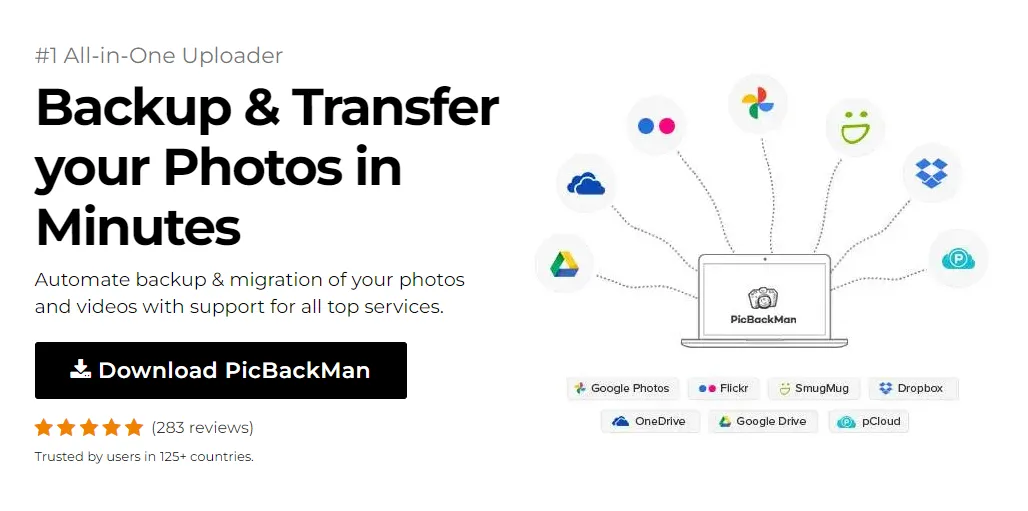
Why is it the #1 bulk uploader?
- Insanely fast!
- Maintains folder structure.
- 100% automated upload.
- Supports RAW files.
- Privacy default.
How can you get started?
Download PicBackMan and start free, then upgrade to annual or lifetime plan as per your needs. Join 100,000+ users who trust PicBackMan for keeping their precious memories safe in multiple online accounts.
“Your pictures are scattered. PicBackMan helps you bring order to your digital memories.”
iCloud Drive Is Loading: A Comprehensive Guide to Troubleshooting and Optimization


In today's digital age, cloud storage has become an indispensable tool for individuals and businesses alike. Apple's iCloud Drive offers seamless access to files across multiple devices, ensuring convenience and efficiency. However, users may encounter occasional hiccups, such as iCloud Drive loading issues, which can disrupt productivity and cause frustration.
icloud drive is loading: When you encounter the dreaded message indicating that iCloud Drive is loading, it's essential to understand the root causes and explore effective solutions to resolve the issue promptly.
Understanding iCloud Drive Loading Issues
What causes iCloud Drive to load slowly?
iCloud Drive loading issues can stem from various factors, including network connectivity issues, insufficient storage space, outdated software, or conflicts with third-party applications.
How does iCloud Drive loading impact user experience?
The sluggish loading of iCloud Drive can impede access to critical files and hinder workflow efficiency, leading to frustration and productivity loss for users.
icloud drive is loading: Whether you're experiencing intermittent delays or persistent loading issues, it's crucial to address the underlying causes to restore optimal functionality to iCloud Drive.
Troubleshooting Common iCloud Drive Loading Problems
1. Check Network Connectivity
Before delving into complex troubleshooting steps, start by ensuring that your device is connected to a stable and reliable network. Poor network connectivity can significantly impact the performance of iCloud Drive.
2. Verify iCloud Storage Availability
Ensure that your iCloud storage isn't nearing its capacity limit. If your storage is full, iCloud Drive may struggle to load files efficiently. Consider deleting unnecessary files or upgrading your storage plan to accommodate your needs.
3. Update iOS/macOS
Keeping your operating system up to date is essential for maintaining optimal performance and compatibility with iCloud Drive. Check for any available updates and install them to address potential software bugs or compatibility issues.
4. Disable Background App Refresh
Background app refresh can consume valuable resources and bandwidth, potentially causing iCloud Drive loading issues. Disable this feature for non-essential applications to conserve resources and improve performance.
5. Clear iCloud Cache
Over time, cached data and temporary files may accumulate on your device, leading to performance degradation. Clearing the iCloud cache can help alleviate loading issues and improve overall system responsiveness.
6. Reset iCloud Settings
If you're still experiencing iCloud Drive loading problems, consider resetting your iCloud settings. This action will revert your iCloud settings to their default state, potentially resolving any configuration issues causing the slowdown.
Optimizing iCloud Drive Performance
1. Enable iCloud Drive Optimizations
Take advantage of iCloud Drive optimizations, such as optimizing storage and syncing files on-demand. These features help conserve storage space and ensure that essential files are readily accessible without consuming unnecessary bandwidth.
2. Organize Files and Folders
Maintaining a well-organized folder structure within iCloud Drive can streamline file access and improve overall efficiency. Create logical folders and categorize files appropriately to facilitate quick retrieval.
3. Utilize iCloud Drive Collaborative Features
Explore iCloud Drive's collaborative features, such as shared folders and real-time collaboration on documents. These functionalities enhance teamwork and streamline workflow processes, contributing to improved productivity.
4. Utilize iCloud Drive Across Devices
Seamlessly access your files across multiple devices by enabling iCloud Drive on all your Apple devices. This ensures continuity and flexibility in your workflow, allowing you to pick up where you left off regardless of the device you're using.
5. Monitor iCloud Drive Activity
Regularly monitor iCloud Drive activity to identify any unusual patterns or issues promptly. Utilize built-in tools or third-party applications to track resource usage and diagnose potential performance bottlenecks.
6. Optimize Network Settings
Fine-tune your network settings to prioritize iCloud Drive traffic and ensure smooth performance. Adjust router settings, such as Quality of Service (QoS) parameters, to allocate sufficient bandwidth to iCloud Drive activities.
Quick Tip to ensure your videos never go missing
Videos are precious memories and all of us never want to ever lose them to hard disk crashes or missing drives. PicBackMan is the easiest and simplest way to keep your videos safely backed up in one or more online accounts. Simply Download PicBackMan (it's free!), register your account, connect to your online store and tell PicBackMan where your videos are - PicBackMan does the rest, automatically. It bulk uploads all videos and keeps looking for new ones and uploads those too. You don't have to ever touch it.
FAQs (Frequently Asked Questions)
Why is my iCloud Drive still loading?
There could be several reasons why your iCloud Drive is still loading:
-
Slow internet connection: iCloud Drive relies on a stable internet connection to sync and load your files. If your network speed is slow, it can take longer for your iCloud Drive to fully load.
-
Large amount of data: If you have a significant amount of data stored in your iCloud Drive, it may take longer to load all the files and folders, especially if you're accessing it from a new device or after a long period of inactivity.
-
Server issues: Occasionally, there may be temporary issues with Apple's iCloud servers, which can cause delays in loading iCloud Drive or other iCloud services.
-
Software updates: If there are pending software updates for your device or iCloud Drive, the loading process may be slower until the updates are installed.
-
Device performance: If you're using an older device with limited processing power or memory, it may struggle to load and display the contents of your iCloud Drive efficiently.
Why is my iCloud not loading?
There could be several reasons why your iCloud is not loading:
-
Internet connection issues: iCloud requires a stable internet connection to function properly. If you're experiencing network issues or a poor internet connection, it may prevent iCloud from loading.
-
Server maintenance or outages: Occasionally, Apple's iCloud servers may undergo maintenance or experience outages, which can temporarily prevent iCloud and its services from loading or functioning correctly.
-
Software or app issues: If there are software conflicts or issues with the iCloud app or related apps on your device, it may prevent iCloud from loading properly.
-
Account issues: If there are any problems with your Apple ID or iCloud account, such as incorrect login credentials or account restrictions, it can prevent iCloud from loading.
-
Device compatibility: iCloud may not load correctly if you're using an outdated or unsupported device or operating system version that is incompatible with the latest iCloud features or requirements.
Why is iCloud Drive taking so long?
iCloud Drive may take a long time to load or sync for several reasons:
-
Large file transfers: If you're uploading or downloading a large number of files or large file sizes to iCloud Drive, the transfer process can be time-consuming, especially with slower internet connections.
-
Initial sync: When you first set up iCloud Drive on a new device or after a long period of inactivity, the initial sync process can take a substantial amount of time, especially if you have a lot of data stored in your iCloud Drive.
-
Network congestion: If there is high network traffic or congestion on your internet connection or Apple's servers, it can slow down the transfer speeds and cause iCloud Drive to take longer to sync or load.
-
Device performance: Older devices or devices with limited processing power and memory may struggle to handle the workload of syncing and loading iCloud Drive efficiently, resulting in slower performance.
-
Software issues: Occasionally, software bugs or compatibility issues with the iCloud Drive app or related apps can cause delays or slow performance during the loading or syncing process.
Why is my iCloud storage not loading?
If your iCloud storage is not loading, it could be due to the following reasons:
-
Internet connection issues: iCloud storage requires a stable internet connection to load and access your stored data. If you're experiencing network connectivity problems or a poor internet connection, it may prevent your iCloud storage from loading.
-
Server issues: Occasionally, there may be temporary issues or outages with Apple's iCloud servers, which can cause problems with loading iCloud storage or other iCloud services.
-
Software or app conflicts: Software conflicts or issues with the iCloud app or related apps on your device may interfere with the proper loading of your iCloud storage.
-
Account or authentication problems: If there are any issues with your Apple ID or iCloud account credentials, such as incorrect login information or account restrictions, it can prevent your iCloud storage from loading properly.
-
Device compatibility: Using an outdated or unsupported device or operating system version that is incompatible with the latest iCloud features or requirements may cause issues with loading your iCloud storage.
Why is my iCloud taking so long to load on my new phone?
There are a few reasons why your iCloud may be taking a long time to load on your new phone:
-
Initial sync: When you set up iCloud on a new device, it needs to sync all your data (photos, contacts, messages, etc.) from your previous device or iCloud storage. This initial sync process can be time-consuming, especially if you have a large amount of data to transfer.
-
Network speed: If your internet connection is slow or unstable, it can significantly impact the speed at which your iCloud data can be transferred and loaded on your new phone.
-
Device performance: Older or lower-end devices with limited processing power and memory may struggle to handle the workload of syncing and loading your iCloud data efficiently, resulting in slower performance.
-
Server load: If there is a high volume of users trying to access iCloud servers simultaneously, it can lead to increased server load and slower loading times for individual users.
-
Software updates: If there are pending software updates for your new phone or iCloud services, the loading process may be slower until the updates are installed and applied.
How do I load storage on iCloud?
To load storage on iCloud, follow these steps:
-
Sign in to your iCloud account: Make sure you're signed in to your Apple ID and iCloud account on your device.
-
Enable iCloud storage: Go to Settings > [Your Name] > iCloud > iCloud Storage, and turn on iCloud Storage.
-
Choose what to store: Under the "iCloud" section in Settings, you can select which app data you want to store in iCloud, such as Photos, Contacts, Calendars, Notes, and more.
-
Manage storage: In the iCloud Storage settings, you can view your available storage space, manage your storage plan, and optimize your storage by enabling features like iCloud Photos and iCloud Drive.
-
Upload data: Once you've enabled the desired iCloud services and selected what data to store, your device will start uploading and syncing that data to your iCloud storage automatically.
-
Wait for sync: Depending on the amount of data you're uploading and your internet connection speed, the initial sync process may take some time. You can monitor the progress in the iCloud settings or the individual app settings.
Remember, iCloud storage requires an active iCloud subscription, and you may need to upgrade your storage plan if you run out of space.
Conclusion
In conclusion, iCloud Drive is a powerful tool for storing, accessing, and syncing files across Apple devices. However, users may encounter loading issues that can disrupt workflow efficiency. By following the troubleshooting tips and optimization techniques outlined in this guide, you can address iCloud Drive loading problems effectively and enhance your overall user experience. Remember to stay proactive in monitoring iCloud Drive activity and leverage its collaborative features to maximize productivity and convenience in your digital workflow.






